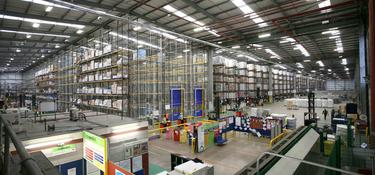
The internet, e-commerce, mobile communications, and urbanization are driving a revolution in retail, and, as a result, changing the nature of the warehouse as we know it.
In retail, logistics used to be back of mind. Warehouses and distribution centers were planted in remote locations, where costs for land, labor, and taxes were low. Thanks to the demands of e-commerce, which is still in its infancy in terms of growth, last century’s warehouses—out-of-the-way, passive, cookie-cutter boxes—have evolved into this century’s technology-rich logistics facilities. For a growing number of companies, be they online retail giants, start-ups or brick-and-mortar chains building out e-commerce capabilities, logistics facilities already perform many of the functions of a store.
As today’s cell-in-hand teens enter their prime shopping years they will visit malls with less frequency, and new technology, like virtual reality, will give more consumers comfort in buying apparel online. Global online sales are poised to top $2 trillion in 2016—up from less than $1 trillion in 2011. Yet they account for just 8.6 percent of all retail sales. By 2020, according to estimates from e-Marketer and Prologis Research, total sales could double again to $4 trillion, at which point they’ll account for nearly 15 percent of total sales.
Warehouses are beginning to assume some of the characteristics of stores as more retailing activity starts to happen inside distribution centers: they’re highly varied in size, shape, purpose, and intent, and deploy technology to meet rising customer service expectations. This means e-commerce managers have to think differently about the location of their distribution centers. Successful retail stores can thrive only to the extent that they are accessible to large numbers of customers. Just so, logistics spaces that serve e-commerce interests are also often best placed near population centers. That way they can better facilitate speedy “last-mile” delivery.
Having logistics space closer to customers can play a big role in reducing transportation costs and time to deliver, which is vital for the highly competitive e-commerce industry. That’s why many e-commerce companies and other retailers are finding “infill” locations—sites within urban areas that are repurposed for logistics, as opposed to greenfield exurban sites—are becoming a prime imperative.
Just as retail spaces run the gamut from pop-up micro-stores to multi-level emporia, e-commerce-supporting logistics buildings come in all shapes and sizes. The world’s giant online retailers, such as Amazon, JD.com and Walmart, all of which have online revenues of more than $10 billion and can ship more than 250,000 orders per day, tend to favor larger and more functional buildings. Big brands like Tesco, Home Depot and Uniqlo, which are developing e-fulfillment networks, maintain a combination of mid-sized and large facilities. Younger brands such as Wayfair, HelloFresh, and Zooplus often only need a single fulfillment location or a small portion of a bigger facility. Third-party logistics and parcel delivery companies like UPS and FedEx also are jostling for position in key locations. This is leading to growth for everything from units smaller than 10,000 square feet all the way up to more than 1 million square feet.
Going forward, retailers will exist and thrive in mixed-use urban areas, population centers and near emerging transit hubs. The same will hold for virtual stores—the logistics facilities that service e-commerce. Topline e-commerce activity and underlying demand for real estate have enjoyed significant growth in the last year. In spite of immense growth, e-commerce infrastructure is still undeveloped, especially in the infill locations that facilitate last-mile delivery. It’s only the beginning of the process through which retailers will scale up their operations and continue to experiment with a range of e-commerce concepts, strategies and supply chain arrangements.
Those of us in the logistics business are excited to see what’s in store for the future of these virtual stores.
About Chris
Chris Caton is the Senior Vice President, Global Head of Research for Prologis (NYSE: PLD), the global leader in industrial logistics real estate across the Americas, Europe, and Asia. Prologis’ research department studies fundamental and investment trends and Prologis’ customers’ needs to assist in identifying opportunities and avoiding risk across four continents. It publishes research on the market dynamics impacting Prologis’ customers’ businesses, including global supply chain issues and developments in the logistics and real estate industries.


